Preferences¶
Make changes to channel settings graphically in the UI.
Plugin Type: Local
Preferences is a local plugin, which means it is associated with a
channel. An instance can be opened for each channel.
Usage
The Preferences plugin sets the preferences on a per-channel basis.
The preferences for a given channel are inherited from the “Image”
channel until they are explicitly set and saved using this plugin.
If “Save Settings” is pressed, it will save the settings to the user’s home Ginga folder so that when a channel with the same name is created in future Ginga sessions it will obtain the same settings.
Color Distribution Preferences

“Color Distribution” preferences.¶
The “Color Distribution” preferences control the preferences used for the data value to color index conversion that occurs after cut levels are applied and just before final color mapping is performed. It concerns how the values between the low and high cut levels are distributed to the color and intensity mapping phase.
The “Algorithm” control is used to set the algorithm used for the mapping. Click the control to show the list, or simply scroll the mouse wheel while hovering the cursor over the control. There are eight algorithms available: linear, log, power, sqrt, squared, asinh, sinh, and histeq. The name of each algorithm is indicative of how the data is mapped to the colors in the color map. “linear” is the default.
Color Mapping Preferences
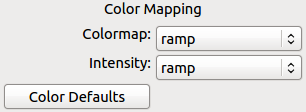
“Color Mapping” preferences.¶
The “Color Mapping” preferences control the preferences used for the color map and intensity map, used during the final phase of the color mapping process. Together with the “Color Distribution” preferences, these control the mapping of data values into a 24-bpp RGB visual representation.
The “Colormap” control selects which color map should be loaded and used. Click the control to show the list, or simply scroll the mouse wheel while hovering the cursor over the control.
The “Intensity” control selects which intensity map should be used with the color map. The intensity map is applied just before the color map, and can be used to change the standard linear scale of values into an inverted scale, logarithmic, etc.
Ginga comes with a good selection of color maps, but should you want
more, you can add custom ones or, if matplotlib is installed, you
can load all the ones that it has.
See “Customizing Ginga” for details.
Zoom Preferences
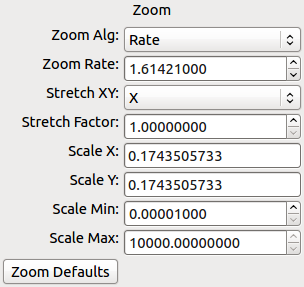
“Zoom” preferences.¶
The “Zoom” preferences control Ginga’s zooming/scaling behavior. Ginga supports two zoom algorithms, chosen using the “Zoom Alg” control:
The “step” algorithm zooms the image inwards in discrete steps of 1X, 2X, 3X, etc. or outwards in steps of 1/2X, 1/3X, 1/4X, etc. This algorithm results in the least artifacts visually, but is a bit slower to zoom over wide ranges when using a scrolling motion because more “throw” is required to achieve a large zoom change (this is not the case if one uses of the shortcut zoom keys, such as the digit keys).
The “rate” algorithm zooms the image by advancing the scaling at a rate defined by the value in the “Zoom Rate” box. This rate defaults to the square root of 2. Larger numbers cause larger changes in scale between zoom levels. If you like to zoom your images rapidly, at a small cost in image quality, you would likely want to choose this option.
Note that regardless of which method is chosen for the zoom algorithm,
the zoom can be controlled by holding down Ctrl (coarse) or Shift
(fine) while scrolling to constrain the zoom rate (assuming the default
mouse bindings).
The “Stretch XY” control can be used to stretch one of the axes (X or Y) relative to the other. Select an axis with this control and roll the scroll wheel while hovering over the “Stretch Factor” control to stretch the pixels in the selected axis.
The “Scale X” and “Scale Y” controls offer direct access to the underlying scaling, bypassing the discrete zoom steps. Here, exact values can be typed to scale the image. Conversely, you will see these values change as the image is zoomed.
The “Scale Min” and “Scale Max” controls can be used to place a limit on how much the image can be scaled.
The “Zoom Defaults” button will restore the controls to the Ginga default values.
Pan Preferences

“Pan” preferences.¶
The “Pan” preferences control Ginga’s panning behavior.
The “Pan X” and “Pan Y” controls offer direct access to set the pan position in the image (the part of the image located at the center of the window) – you can see them change as you pan around the image.
The “Center Image” button sets the pan position to the center of the image, as calculated by halving the dimensions in X and Y.
The “Mark Center” check box, when checked, will cause Ginga to draw a small reticle in the center of the image. This is useful for knowing the pan position and for debugging.
Transform Preferences
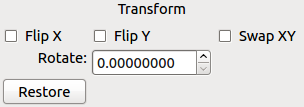
“Transform” preferences.¶
The “Transform” preferences provide for transforming the view of the image by flipping the view in X or Y, swapping the X and Y axes, or rotating the image in arbitrary amounts.
The “Flip X” and “Flip Y” checkboxes cause the image view to be flipped in the corresponding axis.
The “Swap XY” checkbox causes the image view to be altered by swapping the X and Y axes. This can be combined with “Flip X” and “Flip Y” to rotate the image in 90 degree increments. These views will render more quickly than arbitrary rotations using the “Rotate” control.
The “Rotate” control will rotate the image view the specified amount. The value should be specified in degrees. “Rotate” can be specified in conjunction with flipping and swapping.
The “Restore” button will restore the view to the default view, which is unflipped, unswapped, and unrotated.
Auto Cuts Preferences
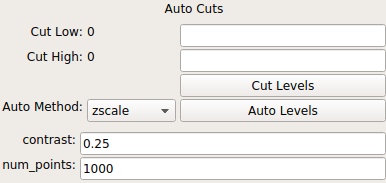
“Auto Cuts” preferences.¶
The “Auto Cuts” preferences control the calculation of cut levels for the view when the auto cut levels button or key is pressed, or when loading a new image with auto cuts enabled. You can also set the cut levels manually from here.
The “Cut Low” and “Cut High” fields can be used to manually specify lower and upper cut levels. Pressing “Cut Levels” will set the levels to these values manually. If a value is missing, it is assumed to default to the whatever the current value is.
Pressing “Auto Levels” will calculate the levels according to an algorithm. The “Auto Method” control is used to choose which auto cuts algorithm used: “minmax” (minimum maximum values), “median” (based on median filtering), “histogram” (based on an image histogram), “stddev” (based on the standard deviation of pixel values), or “zscale” (based on the ZSCALE algorithm popularized by IRAF). As the algorithm is changed, the boxes under it may also change to allow changes to parameters particular to each algorithm.
WCS Preferences

“WCS” preferences.¶
The “WCS” preferences control the display preferences for the World Coordinate System (WCS) calculations used to report the cursor position in the image.
The “WCS Coords” control is used to select the coordinate system in which to display the result.
The “WCS Display” control is used to select a sexagesimal (H:M:S)
readout or a decimal degrees readout.
New Image Preferences
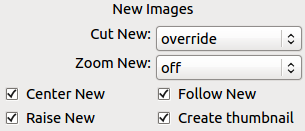
“New Image” preferences.¶
The “New Images” preferences determine how Ginga reacts when a new image
is loaded into the channel. This includes when an older image is
revisited by clicking on its thumbnail in the Thumbs plugin pane.
The “Cut New” setting controls whether an automatic cut-level calculation should be performed on the new image, or whether the currently set cut levels should be applied. The possible settings are:
“on”: calculate a new cut levels always;
“override”: calculate a new cut levels until the user overrides it by manually setting a cut levels, then turn “off”; or
“off”: always use the currently set cut levels.
Tip
The “override” setting is provided for the convenience of
having automatic cut levels, while preventing a manually set
cuts from being overridden when a new image is ingested. When
typed in the image window, the semicolon key can be used to
toggle the mode back to override (from “off”), while colon will
set the preference to “on”. The Info panel shows
the state of this setting.
The “Zoom New” setting controls whether a newly visited image should be zoomed to fit the window. There are three possible values: on, override, and off:
“on”: the new image is always zoomed to fit;
“override”: images are automatically fitted until the zoom level is changed manually, then the mode automatically changes to “off”, or
“off”: always use the currently set zoom levels.
Tip
The “override” setting is provided for the convenience of
having an automatic zoom, while preventing a manually set zoom
level from being overridden when a new image is ingested. When
typed in the image window, the apostrophe (a.k.a. “single quote”)
key can be used to toggle the mode back to “override” (from
“off”), while quote (a.k.a. double quote) will set the preference
to “on”. The global plugin Info panel shows the state of this
setting.
The “Center New” box, if checked, will cause newly visited images to always have the pan position reset to the center of the image. If unchecked, the pan position is unchanged from the previous image.
The “Follow New” setting is used to control whether Ginga will change
the display if a new image is loaded into the channel. If unchecked,
the image is loaded (as seen, for example, by its appearance in the
Thumbs tab), but the display will not change to the new image. This
setting is useful in cases where new images are being loaded by some
automated means into a channel and the user wishes to study the current
image without being interrupted.
The “Raise New” setting controls whether Ginga will raise the tab of a channel when an image is loaded into that channel. If unchecked, then Ginga will not raise the tab when an image is loaded into that particular channel.
The “Create Thumbnail” setting controls whether Ginga will create a thumbnail for images loaded into that channel. In cases where many images are being loaded into a channel frequently (e.g., a low frequency video feed), it may be undesirable to create thumbnails for all of them.
General Preferences
The “Num Images” setting specifies how many images can be retained in buffers in this channel before being ejected. A value of zero (0) means unlimited–images will never be ejected. If an image was loaded from some accessible storage and it is ejected, it will automatically be reloaded if the image is revisited by navigating the channel.
The “Sort Order” setting determines whether images are sorted in the channel alphabetically by name or by the time when they were loaded. This principally affects the order in which images are cycled when using the up/down “arrow” keys or buttons, and not necessarily how they are displayed in plugins like “Contents” or “Thumbs” (which generally have their own setting preference for ordering).
The “Use scrollbars” check box controls whether the channel viewer will show scroll bars around the edge of the viewer frame.
Remember Preferences
When an image is loaded, a profile is created and attached to the image metadata in the channel. These profiles are continuously updated with viewer state as the image is manipulated. The “Remember” preferences control which parts of these profiles are restored to the viewer state when the image is navigated to in the channel:
“Restore Scale” will restore the zoom (scale) level
“Restore Pan” will restore the pan position
“Restore Transform” will restore any flip or swap axes transforms
“Restore Rotation” will restore any rotation of the image
“Restore Cuts” will restore any cut levels for the image
“Restore Scale” will restore any coloring adjustments made (including color map, color distribution, contrast/stretch, etc.)